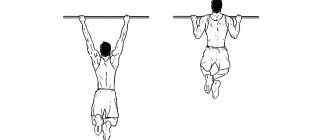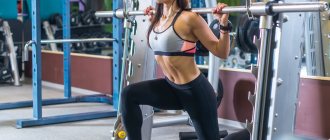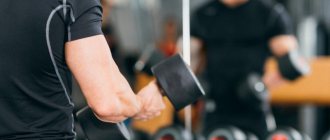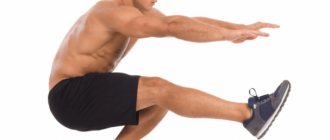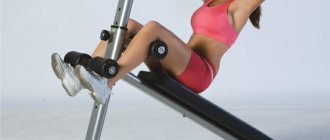The 7 shoulder training programs given in the article will help you figure out what exercises you can do to pump up your deltoids. Each set of shoulder exercises will help pump up the entire shoulder girdle and work out all the deltoid muscle bundles and separately, the middle, anterior and posterior ones.
- How to pump up your shoulders
- How to build big shoulders: training for mass Shoulder training program for mass
- Shoulder training for relief
- Training program
- A set of exercises for the middle deltoids
- A set of exercises for the rear deltoids
- A set of exercises for the front deltoids
How to pump up your shoulders
There are no two people who would train exactly the same way and build big shoulders. Each athlete performs a different sequence of exercises, number of approaches, uses different weights and length of rest periods. This article will help everyone figure out how to pump up their shoulders in the gym or at home.
Individuality is an inherent property of a person, and there is nothing wrong with that, but it imposes restrictions on how to pump up the deltoid muscles for an individual person. Certain principles and approaches make training better, especially when it comes to the question of how to quickly pump up your shoulders. Therefore, I have compiled 7 really effective sets of shoulder exercises, each of which will tell you how to pump your shoulders for relief, width and mass.
Please note that the order of exercises, weights, number of repetitions and volume can be changed to find the best way for you to pump up the deltoid muscles. Once you choose a workout that works for you, follow it for 4-8 weeks and then return to your usual routine or try another one from this list.
Notes:
- Below we will mainly talk about how to pump up your shoulders in the gym, but some of the programs are well suited for training at home.
- The given sets of exercises do not include warm-up. When warming up, perform as many reps as you need, but never reach muscle failure.
- Choose a weight that will allow you to reach muscle failure in the prescribed number of repetitions. This will be the correct pumping of the shoulders in order to involve the maximum number of delta muscle fibers in the work and achieve muscle growth.
- If you're training with a partner, do a few forced reps on your heaviest set of overhead presses. If not, then perform a drop set on the last set of each exercise, reducing the weight by about 25% when muscle failure is reached. In total it needs to be achieved 2 times.
Seated dumbbell bench press
The seated front dumbbell press is also the most effective pressing exercise for the shoulder muscles. It accentuates the load on the front bundles and makes good use of the middle ones. Since the exercise is performed on a bench with a backrest, this allows you to increase the load on the target muscles.
- To perform the exercise, you will need dumbbells and a bench with an adjustable backrest. The backrest must be installed at the smallest angle from the vertical (80-90 degrees) so that the plane of movement of the dumbbells passes in front of the head. The bench seat can be adjusted for comfort.
- The exercise involves vertically lifting dumbbells in front of your head. The top point is that the dumbbells are on outstretched arms, the bottom point is that the dumbbells are at chin level. In the exercise, you must try to perform the maximum amplitude of movement.
The exercise consists of 1 warm-up approach and 3 working sets. The warm-up approach is done with 60-70% of the working weight. Number of repetitions in warm-up and working approaches: 8-12.
For a visual representation of how to perform the exercise correctly, watch the video below:
Exercises for shoulders. Seated dumbbell press.
How to build big shoulders: mass training
Goal: building up all the deltoids
The most effective method for pumping up your shoulders in the gym is to work with heavy weights, but you need to approach the training correctly so as not to get injured. To do this, you need to warm up well and follow the exercise technique.
To build shoulder mass, always start your workout with the most difficult exercises (in this case, overhead presses) that allow you to lift more weight. Then perform single-joint exercises on each of the three deltoids: anterior, middle, and posterior. This will set the stage for muscle building work as long as you maintain your overall training volume.
When we pump our shoulders, we can complicate the training in several ways. For the overhead press, start by using dumbbells, which are notoriously more difficult to balance and allow for a greater range of motion than a barbell. You'll also do the reverse pyramid because it gives you the opportunity to do more sets with muscle failure. For the first 2 sets, you'll use fairly heavy weights in a low rep range (6) to build strength. As fatigue accumulates in subsequent approaches, reduce the weight by about 5 kg. Perform the last 2 heaviest approaches with a belay partner so that you can maintain technique.
Because the front delts do a lot of the work in chest training, and the middle delts bear the brunt of the weight during the overhead press, the rear delts often remain small and weak. In this workout, shoulder pumping takes place when you have a lot of strength in reserve. At the same time, don't be afraid to change the order of single-joint exercises based on your weaknesses. If you think that all of your deltoids are proportionally developed, simply perform these exercises in a different order at each workout.
Massive shoulder training program
- Dumbbell overhead press - 4 sets of 6,6,8,10 reps (2 minutes rest)
- Barbell rows to the chin - 3 sets of 8,8,10 reps (2 minutes rest)
- Bent-over dumbbell raises - 3 sets of 8, 10, 12 reps (1 minute rest)
- Standing dumbbell lateral raises - 3 sets of 8,10,12 reps (1 minute rest)
- Lifting the barbell overhead with straight arms - 3 sets of 8,10,12 reps (1 minute rest)
Recommendations for shoulder training in the gym
Before starting classes, familiarize yourself with the basic principles of deltoid training:
- The deltoid muscle is divided by fascia into three bundles. Therefore, it is necessary to train it with different exercises: pressing, pulling, swinging.
- To pump up your shoulders in the gym, combine basic and isolation exercises in one session. This way you can fully utilize muscle fibers.
- Use both standard training schemes and advanced techniques, such as supersets. This will help add variety to your classes and improve the development of deltas.
- To “break through” the deltoids and make them grow, perform the required amount of training: in basic exercises - 3-4 sets of 8-12 repetitions, in isolating exercises - 3-4 of 12-15.
- The shoulder joint is made up of many bones and ligaments, which allows for mobility but also increases the risk of injury. To avoid this, be sure to warm up .
- If you work out according to the classic split scheme, then perform deltoids exercises in the gym on the same day as working out your back or legs. Chest training already stresses the shoulders without special exercises.
How to build sculpted shoulders
Goal: definition of deltas
Here you will learn a good way to pump up deltoids by drawing individual fibers. Lifting light weights for high reps is no longer considered the best way to achieve delt definition. First and foremost, this indoor shoulder workout aims to stimulate muscle growth (moderate weights in a moderate rep range). To increase the number of calories burned during and after training (post-exercise oxygen consumption effect), high volume is used in combination with supersets. Here you will move faster and feel a real burning sensation in your muscles. Now you know how to pump up your muscles so that they are not only sculpted, but also the so-called “cut” appears.
Shoulder training for relief
- Seated military press - 4 sets of 8-12 reps (2 minutes rest)
- Standing Dumbbell Raises - Superset: 3 sets of 10-12 reps (no rest)
- Bent-over dumbbell raises - 3 sets of 10-12 reps (60-90 seconds rest)
- Raising your arm in front of you in a crossover - 3 sets of 10-12 repetitions (without rest)
- Crossover Chin Row - 3 sets of 10-12 reps (60-90 seconds rest)
- Butterfly raises - 3 sets of 10-12 repetitions (without rest)
- Raises of arms to the sides with an expander - 3 sets of 10-12 repetitions (60-90 seconds for rest)
Recommendations and tips
There are several simple tips on how to pump your shoulders with a barbell to reduce discomfort and increase the effectiveness of your training. Here are some of them:
- We pump our shoulders with a barbell correctly. Don't use too wide a grip. This can lead to a decrease in efficiency because it reduces the range of motion. In addition, the risk of injury increases if the weight of the projectile is miscalculated.
- The exercise should keep all muscles tense. Yes, the load is distributed to varying degrees, but it must be throughout the body, otherwise there is a chance of missing an important muscle group.
- You should not raise your head to protect yourself from hitting your chin on the bar. Instead, it's better to pull it back a little. In this case, the trajectory of the bar will remain ideal.
After each workout, weak points should be monitored. If there is a feeling of deficiency, the next session should be devoted to this particular muscle group.
Standing Barbell Press. Shoulder Exercise.
How to quickly pump up your shoulders
Goal: mastering the technique and providing a solid foundation for further training.
This complex consists of overhead presses and single-joint exercises for each deltoids. Start with a machine to learn the movements before moving on to free weights, which are best for building muscle.
Start with a light load and focus on proper technique. Add weight only when you can fully control the movement.
Training program
- Machine Overhead Press - 3 sets of 12 reps (60-90 seconds rest)
- Standing Dumbbell Raises - 3 sets of 12 reps (60-90 seconds rest)
- Crossover Front Raise - 3 sets of 12 reps (60-90 seconds rest)
- Butterfly raises - 3 sets of 12 reps (60-90 seconds rest)
How to pump up your middle deltoids
Goal: building up the middle deltoid muscles To make your shoulders wider, you need to develop the middle deltoid muscles. This will also allow the waist to appear narrower and give rise to a wider shoulder girdle. The emphasis in this program, naturally, is on exercises for the middle deltas.
You will perform them at the beginning of the workout, when energy is at its highest level. You can alternate this program with a more balanced delt workout (like mass) during your weekly split.
A set of exercises for the middle deltoids
- Seated overhead press - 4 sets of 8 reps (2 minutes rest)
- Barbell Chin Row - 3 sets of 8-10 reps (60-90 seconds rest)
- One-arm dumbbell lateral raises - 3 sets of 10 reps (60-90 seconds rest)
- Standing dumbbell lateral raises - 3 sets of 10-12 reps (60-90 seconds rest)
Swing dumbbells to the sides while standing
Swinging dumbbells to the sides while standing is an exercise for developing the middle bundle of the shoulder deltas. The exercise is one of the additional (finishing) exercises that should be done after the basic/press exercises.
- To perform the exercise, we only need dumbbells as equipment, as well as the correct technique.
- The mechanics of execution is to raise the dumbbells to the sides. During the extension, the arms from the shoulder to the elbow are in the plane of the body. The brushes move slightly forward. At the top point of the dumbbells at shoulder level or slightly lower, elbows at or slightly higher than the dumbbells, the handles of the dumbbells are parallel to the floor. At the lowest point, the dumbbells are on the thigh muscles, the arms are slightly bent.
The exercise consists of 1 warm-up approach and 3 working sets. The warm-up approach is done with 60-70% of the working weight. Number of repetitions in warm-up and working approaches: 8-12.
For a visual representation of how to perform the exercise correctly, watch the video below:
It's a STANDING DUMBELL SWING, baby.
How to pump up your rear delts
Goal: building up the posterior deltoid muscles
The posterior deltoid muscles often lag not only in beginners, but also in advanced bodybuilders. Simply put, they don't get as much stimulation as the front and middle deltoids, which are involved in chest exercises and shoulder presses.
To develop your rear delts, perform this routine for 4-8 weeks, or alternate it with a more balanced shoulder workout.
A set of exercises for the rear deltoids
- Overhead Press – 4 sets of 8-10 reps (2 minutes rest)
- Bent-over dumbbell raises - 4 sets of 8 reps (60-90 seconds rest)
- Crossover raises - 3 sets of 10 reps (60-90 seconds rest)
- Butterfly raises - 3 sets of 10-12 reps (60-90 seconds rest)
Smith Overhead Bench Press (Basic Exercise)
This type of exercise is basic for the shoulders.
The emphasis of the load is more shifted to the rear bundle of deltas. Correct execution of the exercise:
- It is better to perform the overhead bench press on a bench with a backrest in a Smith machine. The bench will allow you to fix your spine and relieve significant stress from it during exercise. The Smith machine isolates the auxiliary muscle groups and allows you to use only the shoulder muscles.
- First of all, set the position of the back of the bench strictly vertically. Install the bench in the Smith machine so that the back of the bench moves away from the plane of movement of the bar in the Smith machine by 5-10 centimeters, and the bar falls between the back of the bench and your head during the exercise. Then place the bar in Smith at the height of your arms not being fully extended.
- The mechanics of performing the exercise consist of raising/lowering the barbell from behind the head in a vertical plane. At the top point, the arms are fully extended. At the bottom, the bar drops down to the level of your ears on your head. To accurately track the bottom point of the bar position, you must perform the exercise in front of a mirror.
The exercise consists of 2-3 warm-up approaches and 3 working approaches. Warm-up approaches are done with light weights. The weight of the apparatus in the warm-up approaches gradually approaches the weight in the working approach, preparing the muscles and joints for maximum loads. Number of repetitions in warm-up and working approaches: 8-10.
For a visual representation of how to perform the exercise correctly, watch the video below:
Shoulder training Alexander Yarmolenko bench press in Smith from behind the head.
How to pump up your front delts
Goal: Build Up Your Front Deltoids
If you train your chest frequently, you probably already have well-developed front deltoids. After all, they are involved in all pressing exercises, especially when performing them in an incline position. However, relatively weak anterior deltoids can hinder the process of building up the pectoral muscles. This training is designed to correct this situation.
There should be at least 48 hours between chest and shoulder workouts to allow the muscles to fully recover.
A set of exercises for the front deltoids
- Seated overhead press - 4 sets of 8-12 reps (2 minutes rest)
- Arnold Press - 4 sets of 8-10 reps (2 minutes rest)
- Front dumbbell raises - 3 sets of 10 reps (60-90 seconds rest)
- Crossover arm raise - 3 sets of 10-12 reps (60-90 seconds rest)
What to do if your shoulders don't grow
Goal: Pre-exhaustion of the delts
The triceps can sometimes be the limiting factor in shoulder training, especially in the press. If these muscles always give out before you've properly worked your shoulders, you'll never be able to push your delts to muscle failure and build your shoulders in compound exercises. The practice of pre-exhaustion is designed to correct this situation. This is the best way to properly pump up a lagging muscle. Here you first fatigue the delts with single-joint exercises and then perform overhead presses while the triceps are full. Thus, the deltoids must reach failure before the triceps do.
At the beginning of your workout, do not be tempted to go heavy with weights, as this will put additional stress on your elbow joints. Also, if you feel very tired by the time you get to the compound exercise, do it in a machine. It will be a little safer this way.
Training program
- One-arm lat pulldown - 4 sets of 8-10 reps (60-90 seconds rest)
- Lifting the barbell in front of you with outstretched arms - 3 sets of 10 reps (60-90 seconds rest)
- Butterfly raises - 3 sets of 10 reps (60-90 seconds rest)
- Machine overhead press - 3 sets of 8-10 reps (2 minutes rest)
- Barbell rows to the chin - 3 sets of 10-12 reps (2 minutes rest)
Source: https://www.bodybuilding.com/content/shoulder-workouts-for-men-the-7-best-routines-for-bigger-delts.html



